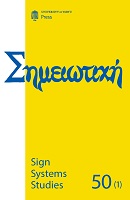Saussure’s dichotomies and the shapes of structuralist semiotics
Saussure’s dichotomies and the shapes of structuralist semiotics
Author(s): John E. JosephSubject(s): Semiotics / Semiology, Theoretical Linguistics, Semiology, Structuralism and Post-Structuralism, Marxism, Phenomenology
Published by: Tartu Ülikooli Kirjastus
Keywords: Semiotics; structuralism; Ferdinand de Saussure; langue and parole; arbitrariness; enunciation; stylistics; Marxism; phenomenology; Louis Hjelmslev; Charles Bally;
Summary/Abstract: The Cours de linguistique générale (1916), which became the master text for structuralist linguistics and semiotics, is characterized by a series of dichotomies. Some of them, e.g. langue and parole, signified and signifier, arbitrary and motivated, are very well known, others less so. This paper looks at Saussure’s semiotics in terms of these dichotomies, and considers how later critiques, such as Voloshinov’s (1929), and reformulations, particularly Hjelmslev’s (1935, 1942) and the concept of enunciation which emerged conjointly in the work of Jakobson, Lacan, Dubois, Benveniste and others, were shaped as responses to the Saussurean dichotomies. Also examined in terms of its contrast with Saussure is Bally’s stylistics. The aim is a fuller understanding of the shapes taken by structuralist semiotics, in view of the heritage on which they were based and the broader intellectual climate, including phenomenology and Marxism, in which they developed.
Journal: Σημειωτκή - Sign Systems Studies
- Issue Year: 50/2022
- Issue No: 1
- Page Range: 11-37
- Page Count: 27
- Language: English

